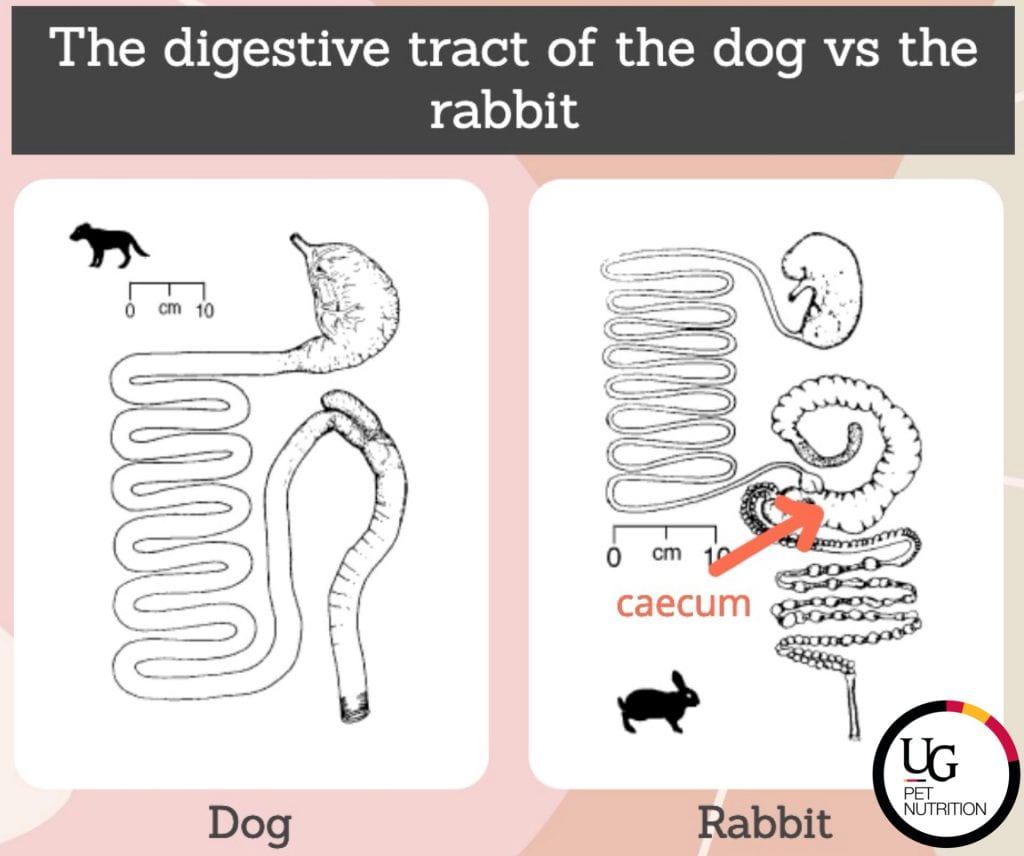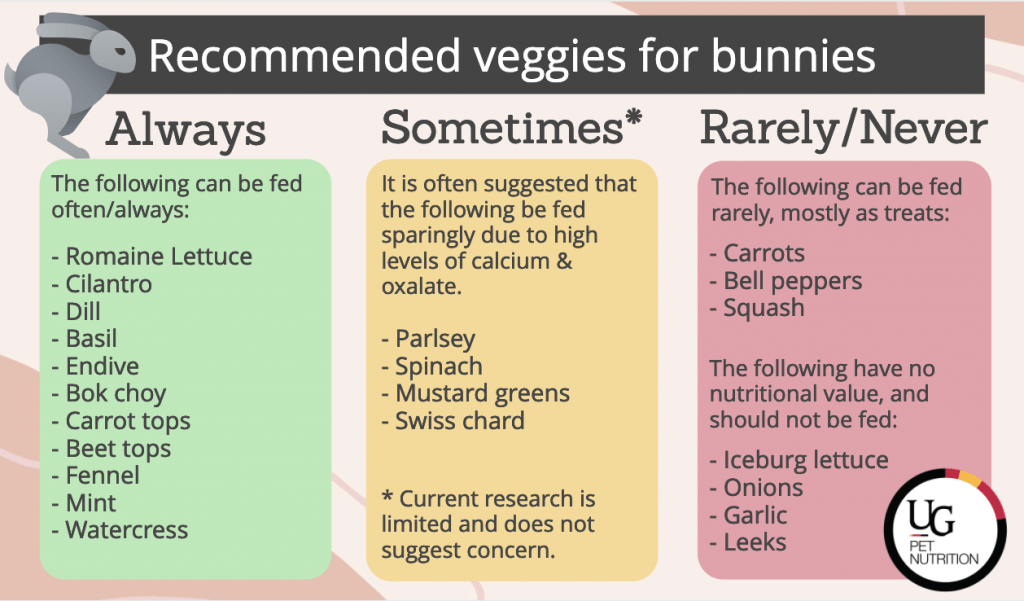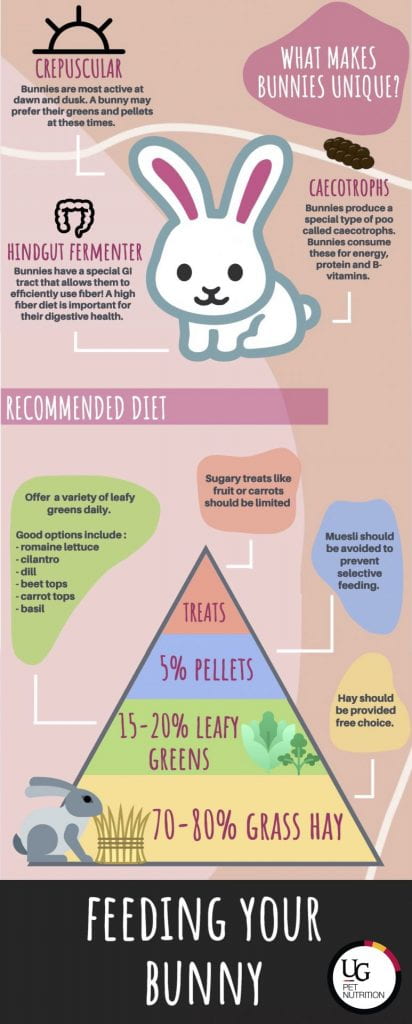Although we cannot imagine Easter without the Easter Bunny, bunnies are also deservingly loved as pets every day of the year.
Bunnies are estimated to be the third most popular pet globally. Additionally, research done by the Ontario Veterinary College’s Dr. Jason Coe found that most people with bunnies as pets described themselves as being very attached to them, similar to how pet owners feel about their dogs or cats.
Digestive Physiology

The digestive physiology and diet of the bunny differs significantly from that of the dog or cat. Believe it or not, bunnies’ gastrointestinal (GI) tracts most resemble the GI tracts of horses rather than cats, dogs or even rodents. This is important to recognize as an inappropriate diet can significantly contribute to the development of dental or GI disorders.
Bunnies are described as hind-gut fermenters, meaning that similar to the horse, bunnies have a very large caecum. This organ can house 10 times the volume of the rabbit’s stomach. The caecum is important for the rabbit as it allows for microbial fermentation of fibre. This allows the bunny to very efficiently digest and make use of a high fiber diet.

Diet
Hay
Although cartoons often show bunnies consuming a large quantity of carrots, bunnies should be consuming mostly fibre-rich foods, such as hay. A bunny should have a constant supply of hay. More specifically, their diet should comprise of 70-80% hay. To meet this large intake, hay should be provided free-choice, meaning always available to the bunny to consume as they wish.

It is recommended that adult rabbits receive exclusively grass hay. Grass hays include varieties such as timothy, orchard, oat and meadow grass. These varieties of hay are widely available at most pet stores. Grass hays are rich in numerous nutrients, including fibre, protein, vitamin A and vitamin D. It is important to note that alfalfa hay should generally not be fed to adult rabbits. This is because of the higher content of energy, protein and calcium of alfalfa hay. Regularly feeding alfalfa hay to an adult bunny may lead to weight gain, urinary sludge and/or bladder stones. For these reasons, alfalfa hay is only recommended for young growing bunnies.
Apart from being important nutritionally, the regular consumption of hay is vital for maintaining the GI and dental health of a bunny, and for providing behavioural enrichment.
Greens
Second to hay, rabbits should be receiving fresh leafy greens daily. These greens are a good source of water and micronutrients for the bunny and are often very palatable. It is recommended that the average bunny’s diet consist of 15-20% leafy greens; equivalent to approximately 1 cup per 2 pounds of body weight (BW).

There are a variety of greens that would be considered excellent options to feed daily, including romaine lettuce, cilantro, dill, basil, endive, bok choy, carrot tops and beet tops. Often it is suggested that plants with high levels of calcium, such as parsley and spinach, be limited due to concerns with the development of stones or urinary sludge. However, plants with high calcium levels also have significant levels of oxalate, a naturally occurring compound found in plants. Based on the published research, rabbits are not able to absorb calcium that is bound to oxalate. Therefore, it appears as though calcium from these greens cannot contribute to urinary disorders, but more research is required on the subject. Iceberg lettuce has little nutritional value to rabbits, and therefore should not be fed. Additionally, feeding onion, garlic and leeks should be avoided as these may cause anemia.
Vegetables high in sugar, such as carrots, and fruit should be offered in a limited quantity only as treats. The general recommendation for these treats is a maximum of 1 teaspoon per 2 pounds of body weight. A high consumption of these treats may lead to GI upset.
Pellets
In addition to hay and veggies, a rabbit’s diet can be supplemented with commercial rabbit feed. Commercial feed should make up about 5% of a bunny’s diet. There are variations in the published recommendations for intake as it will depend on the nutrient density of the feed, the quantity and quality of the hay and greens that the bunny is consuming, as well as their body condition score. Although a body condition scoring chart has not yet been validated in rabbits, the scoring method and advice of the UK’s Pet Food Manufacturer’s Association (PFMA) is most often used.

Food that is a single component (ie: pellets or extruded feed) is recommended. Feeding mixtures, such as a muesli diet, can lead to selective feeding which may cause an imbalanced diet and potentially result in health problems for the bunny. As a result, plain high-fibre timothy-based pellets are preferred. The most common recommendation for house rabbits weighing around 5 pounds appears to be between 1/8-1/4 cup of timothy-based pellets daily. Although OVC Pet Nutrition advocates strongly for pet owners to use a gram scale for weighing their dog’s or cat’s food, in North America, rabbit food manufacturers generally list feeding guidelines on the label in cups and not in grams.
Things to keep in mind
Rabbits are described as being crepuscular, meaning that they are most active around sunrise and sunset. In order to reflect this behaviour, a rabbit should ideally be receiving their fresh greens and pellets split up into two meals daily during these times. Additionally, rabbits appear to enjoy variety. It is recommended that a mixture of various leafy greens and grass hays be offered.
In addition to the above, bunnies receive energy, protein and B-vitamins (niacin, riboflavin, pantothenic acid and cobalamin) from a special type of fecal pellet that they produce and directly consume out of the anus. This special type of poop is called a caecotroph. These are produced in addition to their regular poop.

If a bunny does not eat for more than 8-12 hours, or has stopped defecating, they should be evaluated by a vet. Gastrointestinal stasis, a condition where the movement or passage of food has slowed or stopped, is a medical emergency for rabbits and can be fatal if not treated.
The diet and digestive physiology of the bunny is quite complex, especially as compared to some other pets. This is one of the reasons that bunnies are not recommended as pets for small children. Additionally, as prey animals, bunnies are easily startled by loud noises and brisk movements, and don’t enjoy being picked up.
Always be sure to do your research before purchasing a bunny for yourself or your family. And this Easter, consider chocolate bunnies or stuffed toy bunnies as presents instead!
Written by: Alex Rankovic, BScH, MSc, PhD Candidate
Edited by: Dr. Adronie Verbrugghe, DVM, PhD, EBVS Specialist in Veterinary and Comparative Nutrition® (Dip ECVCN) & Shoshana Verton-Shaw, RVT, VTS (Nutrition)
Resources:
Bradley T. Rabbit care and husbandry. The veterinary clinics of North America. Exotic animal practice. 2004 May 1;7(2):299-313.
Cheeke PR, Amberg JW. Comparative calcium excretion by rats and rabbits. Journal of animal science. 1973 Aug 1;37(2):450-4.
Clauss M, Hatt JM. Evidence-based rabbit housing and nutrition. Veterinary Clinics: Exotic Animal Practice. 2017 Sep 1;20(3):871-84.
De Blas C, Wisewan J, editors. Nutrition of the Rabbit. Cabi; 2020 Feb 11.
Johnson D. Rabbit calcium metabolism, “bladder sludge,” and urolithiasis (Proceedings) [Internet]. DVM360. 2009. Available from: https://www.dvm360.com/view/rabbit-calcium-metabolism-bladder-sludge-and-urolithiasis-proceedings
Kulwich R, Struglia L, Pearson PB. The effect of coprophagy on the excretion of B vitamins by the rabbit. The Journal of nutrition. 1953 Apr 1;49(4):639-45.
Melillo A. Rabbit clinical pathology. Journal of Exotic Pet Medicine. 2007 Jul 1;16(3):135-45.
Meredith A. The Rabbit Digestive System [Internet]. Rabbit Welfare Association and Fund (RWF). 2010. Available from: https://rabbitwelfare.co.uk/wp-content/uploads/2013/05/article-ROWinter10p7.pdf
Meredith A. Rabbit nutrition—an overview. Veterinary Times. 2011 Mar 1;41(5):12-4.
Redrobe S. Calcium metabolism in rabbits. In Seminars in avian and exotic pet medicine 2002 Apr 1 (Vol. 11, No. 2, pp. 94-101). WB Saunders.



